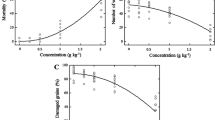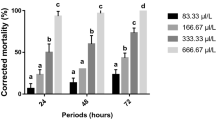Abstract
The survival, feeding response, and detoxification mechanism of Rhynchophorus ferrugineus Olivier, a key pest responsible for destruction of date palm, was examined with different extracts of Piper nigrum and its major constituent (piperine) identified by GC-MS. In the present study, toxicity of different extracts of black pepper was evaluated by incorporating diffferent doses of extracts into the artificial diet of red palm weevil larvae. All extracts showed dose-dependent insecticidal activity to the tested eighth-instar red palm weevil larvae. Among all the extracts, maximum larvicidal activity was exhibited by chloroform (LD50 = 342.62 mg/l), followed by dichloromethane (LD50 = 357.78 mg/l), acetone (LD50 = 372.57 mg/l), and ethanol (LD50 = 408.88 mg/l). However, piperine, a major constituent of all black pepper extracts identified by GC-MS in the present work, was found to be the most potent treatment exhibiting the least LD50 (219.88 mg/l). In addition, nutritional indices evaluated by calculating the efficiency of the conversion of ingested food (ECI) and digested food (ECD) at the same dose (219.88 mg/l) showed that there was maximum reduction in the ECI (49.90%) and ECD (62.21%) index of larvae fed diets incorporated with piperine. Larvae that were fed diets incorporated with different black pepper extracts experienced increases in the expression of detoxification genes (glutathione S-transferase and cytochrome P450), and this upregulation in detoxification genes (glutathione S-transferase, cytochrome P450 and esterase) was tremendously high in larvae fed diets incorporated with piperine. Results suggest that piperine is a promising bio-pesticide agent for the control of R. ferrugineus Olivier.







Similar content being viewed by others
References
Abbott WS (1925) A method of computing the effectiveness of an insecticide. J Econ Entomol 18:265–267. doi:10.1093/jee/18.2.265a
Akhtar Y, Isman MB (2004) Comparative growth inhibitory and antifeedant effects of plant extracts and pure allelochemicals on four phytophagous insect species. J Appl Entomol 128:32–38. doi:10.1046/j.1439-0418.2003.00806.x
Al-Ayedh H, Hussain A, Rizwan-ul-Haq M, Al-Jabr AM (2016) Status of insecticide resistance in field-collected populations of Rhynchophorus ferrugineus (Olivier) (Coleoptera: Curculionidae). Int J Agric Biol 18:103–110. doi:10.17957/IJAB/15.0070
AlJabr AM, Hussain A, Rizwan-ul-Haq M, Al-Ayedh H (2017) Toxicity of plant secondary metabolites modulating detoxification genes expression for natural red palm weevil pesticide development. Molecules 22:169. doi:10.3390/molecules22010169
Boivin T, D’Hieres CC, Bouvier JC, Beslay D, Sauphanor B (2001) Pleiotropy of insecticide resistance in the codling moth, Cydia pomonella. Entomol Exp Appl 99:381–386. doi:10.1046/j.1570-7458.2001.00838.x
Deletre E, Martin T, Campagne P, Bourguet D, Cadin A, Menut C, Bonafos R, Chandre F (2013) Repellent, irritant and toxic effects of 20 plant extracts on adults of the malaria vector Anopheles gambiae mosquito. PLoS One 8:e82103. doi:10.1371/journal.pone.0082103
El-Bokl MM, Baker RF, El-Gammal HL, Mahmoud MZ (2010) Biological and histopathological effects of some insecticidal agents against red palm weevil Rhynchophorus ferrugineus. Egypt Acad J Biol Sci Histol Histochem 1:7–22
Erdogan P, Yildirim A, Sever B (2012) Investigations on the effects of five different plant extracts on the two-spotted mite Tetranychus urticae Koch (Arachnida: Tetranychidae). Psyche A J Entomol 2012:1–5. doi:10.1155/2012/125284
Fan LS, Rita M, Dzolkhifli O, Mawardi R (2011) Insecticidal properties of Piper nigrum fruit extracts and essential oils against Spodoptera litura. Int J Agric Biol 13:517–522
Feng R, Isman M (1995) Selection for resistance to azadirachtin in the green peach aphid, Myzus persicae. Experientia 51:831–833. doi:10.1007/BF01922438
Hussain A, Tian MY, He YR, Ahmed S (2009) Entomopathogenic fungi disturbed the larval growth and feeding performance of Ocinara varians (Lepidoptera: Bombycidae) larvae. Insect Sci 16:511–517. doi:10.1111/j.1744-7917.2009.01272.x
Hussain A, Rizwan-ul-haq M, Al-Jabr AM (2013a) Red palm weevil: understanding the fungal disease mechanism and host defense. In: Microbial pathogens and strategies for combating them: science. Technology and Education. Formatex Research Center, Badajoz, Spain, pp 1278–1286
Hussain A, Rizwan-ul-Haq M, Al-Jabr AM, Al-Ayied HY (2013b) Managing invasive populations of red palm weevil: a worldwide perspective. J Food, Agric Environ 11:456–463
Hussain A, Rizwan-ul-Haq M, Al-Ayedh H, Ahmed S, Al-Jabr AM (2015) Effect of Beauveria bassiana infection on the feeding performance and antioxidant defence of red palm weevil, Rhynchophorus ferrugineus. BioControl 60:849–859. doi:10.1007/s10526-015-9682-3
Hussain A, Rizwan-ul-Haq M, Al-Ayedh H, AlJabr A (2016) Susceptibility and immune defence mechanisms of Rhynchophorus ferrugineus (Olivier) (Coleoptera: Curculionidae) against entomopathogenic fungal infections. Int J Mol Sci 17:1518. doi:10.3390/ijms17091518
Isman MB (2000) Plant essential oils for pest and disease management. Crop Prot 19:603–608. doi:10.1016/S0261-2194(00)00079-X
Isman MB (2006) Botanical insecticides, deterrents, and repellents in modern agriculture and an increasingly regulated world. Annu Rev Entomol 51:45–66. doi:10.1146/annurev.ento.51.110104.151146
Joseph B, Sowmya, Sujatha S (2012) Insight of botanical based biopesticides against economically important pest. Int J Pharm Life Sci 3:2138–2148
Khani M, Awang RM, Omar D, Rahmani M (2012) Bioactivity effect of Piper nigrum L. and Jatropha curcas L. extracts against Corcyra cephalonica [Stainton]. Agrotechnology 2:1–6. doi:10.4172/2168-9881.1000105
Khiyami M, Alyamani E (2008) Aerobic and facultative anaerobic bacteria from gut of red palm weevil (Rhynchophorus ferrugineus). African Jorunal Biotechnol 7:1432–1437
Khosravi R, Sendi JJ, Ghadamyari M, Yezdani E (2011) Effect of sweet wormwood Artemisia annua crude leaf extracts on some biological and physiological characteristics of the lesser mulberry pyralid, Glyphodes pyloalis. J Insect Sci. doi:10.1673/031.011.15601
Liu ZL, Ho SH, Goh SH (2008) Effect of fraxinellone on growth and digestive physiology of Asian corn borer, Ostrinia furnacalis Guenee. Pestic Biochem Physiol 91:122–127. doi:10.1016/j.pestbp.2008.03.003
Livak KJ, Schmittgen TD (2001) Analysis of relative gene expression data using real-time quantitative PCR and the 2−ΔΔCT method. Methods 25:402–408. doi:10.1006/meth.2001.1262
Maia M, Moore SJ (2011) Plant-based insect repellents: a review of their efficacy, development and testing. Malar J 10:S11. doi:10.1186/1475-2875-10-S1-S11
Martinez DST, Freire M das GM, Mazzafera P, Araujo-Júnior RT, Bueno RD, MLR M (2012) Insecticidal effect of labramin, a lectin-like protein isolated from seeds of the beach apricot tree, Labramia bojeri, on the Mediterranean flour moth, Ephestia kuehniella. J Insect Sci 12:62. doi:10.1673/031.012.6201
Rashid M, Khan RA, Zhang YL (2013) Over-expression of cytochrome P450s in Helicoverpa armigera in response to bioinsecticide, cantharidin. Int J Agric Biol 15:993–997
Russell RM, Robertson JL, Savin NE (1977) POLO: a new computer program for Probit analysis. Bull Entomol Soc Am 23:209–213. doi:10.1093/besa/23.3.209
Salama H, Ismail I (2007) Potential of certain natural extracts for the control of the red palm weevil, Rhynchophorus ferrugineus (Oliver). Arch Phytopathol Plant Prot 40:233–236. doi:10.1080/03235400500383669
SAS Institute (2000) SAS user’s guide: statistics. SAS Institute, Cary
Scott IM, Jensen H, Scott JG, Isman MB, Arnason JT, Philogène BJ (2003) Botanical insecticides for controlling agricultural pests: Piperamides and the Colorado potato beetle Leptinotarsa decemlineata say (Coleoptera: Chrysomelidae). Arch Insect Biochem Physiol 54:212–225. doi:10.1002/arch.10118
Scott IM, Helson BV, Strunz GM, Finlay H, Sánchez-Vindas PE, Poveda L, Lyons DB, Philogène BJR, Arnason JT (2007a) Efficacy of Piper nigrum (Piperaceae) extract for control of insect defoliators of forest and ornamental trees. Can Entomol 139:513–522. doi:10.4039/n06-040
Scott IM, Jensen HR, Philogène BJR, Arnason JT (2007b) A review of piper spp. (Piperaceae) phytochemistry, insecticidal activity and mode of action. Phytochem Rev 7:65–75. doi:10.1007/s11101-006-9058-5
Shukla P, Vidyasagar PSPV, Aldosari SA, Abdel-Azim M (2012) Antifeedant activity of three essential oils against the red palm weevil, Rhynchophorus ferrugineus. Bull Insectology 65:71–76
Silva LB, Silva W, Macedo MLR, Peres MTLP (2009) Effects of Croton urucurana extracts and crude resin on Anagasta kuehniella (Lepidoptera: Pyralidae). Brazilian Arch Biol Technol 52:653–664. doi:10.1590/S1516-89132009000300018
Statistix (2003) Statistix 8.1 Tallahassee, FL: Analytical Software.
Su HCF (1977) Insecticidal properties of black pepper to rice weevils and cowpea weevils. J Econ Entomol 70:18–21. doi:10.1093/jee/70.1.18
Tsao R, Peterson CJ, Coats JR (2002) Glucosinolate breakdown products as insect fumigants and their effect on carbon dioxide emission of insects. BMC Ecol 2:5. doi:10.1186/1472-6785-2-5
Yu S, Berry R, Terriere L (1979) Host plant stimulation of detoxifying enzymes in a phytophagous insect. Pestic Biochem Physiol 12:280–284. doi:10.1016/0048-3575(79)90113-5
Zibaee A, Bandani AR (2010) A study on the toxicity of a medicinal plant, Artemisia annua L. (Asteracea) extracts to the Sunn pest, Eurygaster integriceps Puton (Hemiptera: Scutelleridae). J Plant Prot Res 50:79–85. doi:10.2478/v10045-010-0014-4
Acknowledgments
Deanship of King Faisal University (150083) of the Kingdom of Saudi Arabia provided the funds to carry out the whole experimentation.
Author information
Authors and Affiliations
Corresponding author
Additional information
Edited by Moisés J Zotti - UFPel
Rights and permissions
About this article
Cite this article
Hussain, A., Rizwan-ul-Haq, M., Al-Ayedh, H. et al. Toxicity and Detoxification Mechanism of Black Pepper and Its Major Constituent in Controlling Rhynchophorus ferrugineus Olivier (Curculionidae: Coleoptera). Neotrop Entomol 46, 685–693 (2017). https://doi.org/10.1007/s13744-017-0501-7
Received:
Accepted:
Published:
Issue Date:
DOI: https://doi.org/10.1007/s13744-017-0501-7




